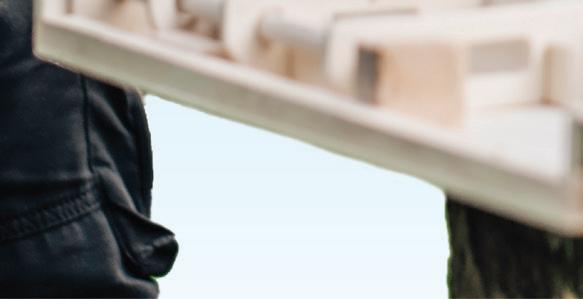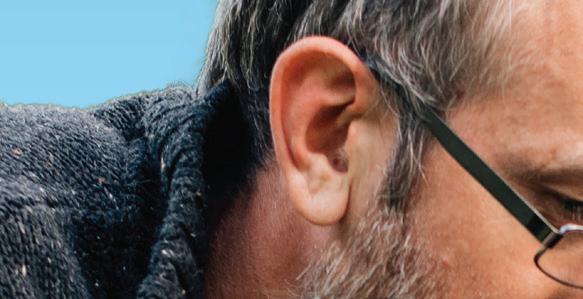


Spring 2023 The member magazine for Durham Wildlife Trust WWW.DURHAMWT.COM
If you would like to opt in to receiving a digital copy of Wildlife Durham instead of your printed copy, please email membership@durhamwt.co.uk with your name and membership number and we will update your preferences.
VISITOR CENTRES
Rainton Meadows Nature Reserve
Chilton Moor, Houghton-le-Spring, Tyne & Wear, DH4 6PU. Tel: 0191 584 3112
The Meadows Coffee Shop
Angela Watson and Team. Tel: 0191 512 8940
Low Barns Nature Reserve
Witton-le-Wear, Bishop Auckland, County Durham, DL14 0AG. Tel: 01388 488 728



Low Barns Coffee Shop
Angela Watson and Team. Tel: 01388 488 729
Charity number: 501038

Paper: FSC accredited, 100% recycled uncoated Design: Edmundson Design www.edmundsondesign.com

Great Things Ahead
There’s every reason to be positive about what Durham Wildlife Trust can achieve in the coming years. We have great people supporting and working for us, big ideas for nature recovery and we’re learning new ways of getting our message across to more people than ever before. All vital ingredients if we want to succeed, but until now there’s always been something missing and progress was slow as a result. What was the missing ingredient? Money.
That perhaps sounds a bit simplistic as the Trust has always been backed by incredibly generous supporters and funders and, as a result, has been able to achieve significant things. We have always made a difference, but the challenges facing the natural world are enormous, and increasing every year as a result of climate change.
In the past, government and the private sector simply weren’t investing the resources needed to address the challenges facing nature. It was left to charities like Durham Wildlife Trust to make the case for nature. Now, government and business seem to have woken up to the economic and social benefits of nature. Not investing in nature simply isn’t an option if society is to prosper.
New legislation is driving investment and Durham Wildlife Trust has more than 50 years’ experience in making a positive difference for people and wildlife across our patch. No one is better placed to make sure that the money that is beginning to become available is invested in the right way. Challenges remain and the scale of investment needed is significant but with great people behind us and a track record of success, Durham Wildlife Trust is ready for the future. And it’s spring!
 Jim Cokill Director
Jim Cokill Director
Many thanks to all our corporate members for their ongoing support

2 Wildlife Durham | Spring 2023
SPRING ISSUE 2023
@durhamwildlife @durhamwildlife @durhamwildlifetrust Gold Members Northern Gas Networks Vine House Farm Silver Members Wienerberger Partners Northumbrian Water Bronze Members Simon Berry Optometrists Holidaycottages.co.uk Airedale Forestry Ltd Verdant Leisure
News Back to Wild Play 3 Great North Fen – becoming a reality 4 Campaigning Nextdoor Nature in Action 6 Projects Link Together 8 People Projects 9 Reserves Round up 10 Education Spotlight on Education 12 Events Member Events 13 National Wildlife Gardening on a Budget 14
Printed by: North Wolds Printers
Cover Image: ‘Blackcap’ by John Stephenson
Back to Wild Play Low Barns Boardwalk
The Wild Play area at Rainton Meadows has reopened after a substantial refit. The work was possible thanks to the support given to our fundraising campaign, along with grants from partners: Sunderland City Council, Integrated Care Board Sunderland, and National Lottery Community Fund. Jim Cokill, Director of Durham Wildlife Trust, said: “The park is a popular destination for many local families, and is a great addition to school and community group visits. We are delighted to have been able to reopen it, thanks to the generosity of our supporters. Thank you to everyone who contributed to the ‘Bringing Back Wild Play’ campaign.”

Class of 2023
Four new Conservation Trainees have recently joined Durham Wildlife Trust. Heidi, Alex, Elaine and Mary-Anne are completing a 12-month traineeship designed to equip them for a career in wildlife conservation. Working with colleagues across the Trust, they will gain the skills and knowledge needed to undertake practical habitat management tasks safely and effectively, and understand the science behind nature restoration. They will also gain experience in other elements of the Trust’s work that are just as vital to the conservation effort – from increasing support to engaging communities and running public events. When asked to sum up her experience after the first month, Heidi said:
“The traineeship is everything I was looking for to help me have a career in nature conservation. No two days are the same and we’re all loving the diversity the role has to offer. From on-the-job practical skills to gaining relevant qualifications, it combines learning with real-world experience.”



We are very pleased to announce that the funding needed to replace the boardwalk at Low Barns has been secured. Donations, and a grant from Impetus Environmental Trust, have made the work possible and the new boardwalk will be constructed from recycled plastic. This not only provides a second life for a problematic waste product, but the material also lasts longer than timber, with lower ongoing maintenance requirements. Like the old boardwalk, the new design will include an area for pond dipping and education activities. Work to remove the existing boardwalk and install the new one will take place in September and October, following bird breeding season.
Durham Wildlife Trust would like to thank the Zephyr Charitable Trust, the Community Foundation’s Curtin PARP Fund, and ALA Green Charitable Trust, for funding the traineeships. Two new trainee positions will be available in the autumn, so if you, or someone you know, are interested, please keep an eye on our social media and website for updates on how to apply.
Wildlife Durham | Spring 2023 3
NEWS
PHOTO CREDIT: PETER BARRON
Great North Fen – becoming a reality

The fundraising campaign for Ricknall Carrs has been a massive success and the vision for a Great North Fen is one step closer to being realised. Thanks to the generosity of the Trust’s members and supporters, the £20,000 fundraising target has been met and the money raised has been used as match funding for a grant application. As a result, Durham Wildlife Trust has been able to negotiate a deal to purchase additional land at Ricknall Carrs. The acquisition of the land should be completed in late spring.
Head of Conservation, Mark Dinning, said: ‘’This is incredibly significant news that will help the Trust deliver major nature restoration work across the Great North Fen area. Planning for the next phases is already underway and there should be more exciting developments to come.’’
Naturally Native Update
“Hi! I’m Charlotte, the new Grants Officer here at Durham Wildlife Trust.
I am a Durham University graduate in Criminology, with experience in working in the bid writing and tender consultancy industry, working on various bids, grants and proposals across both the public and private sectors.










I have always had a passion for wildlife and nature conservation, visiting Costa Rica and Nicaragua in 2016 as part of a World Challenge expedition to engage in turtle conservation work.
I’m looking forward to meeting members and volunteers over the coming months, and gaining as much experience as I can of the Trust’s work. I’ll put that knowledge to good use, securing as much funding as possible to support the Trust’s work to restore nature.”

In December, Durham Wildlife Trust said goodbye to long-standing staff member, Kirsty Pollard. Kirsty joined the Trust in 2010, working initially as the Education and Engagement Officer, and over the last four years as Naturally Native Project Manager, helping to develop and guide water vole conservation work across the North East region. Everyone at the Trust wishes Kirsty and family all the best as they begin their new life in the Cairngorms.
If the Cairngorms wasn’t far enough away to set up a new home, Elliot Lee, Durham Wildlife Trust’s Naturally Native Project Officer, has gone a step further – relocating to New Zealand. Elliot was central in developing and deploying the practical techniques the Trust now uses to restore water vole populations. We hope New Zealand will make the most of his fantastic skills.
In turn, we are pleased to welcome Stephen Brend as the new Naturally Native Project Manager, and Paul Rodgers as Durham Wildlife Trust’s Naturally Native Project Officer.


NEWS
Find out more about the Great North Fen here: durhamwt.com/restoring-durham-carrs
4 Wildlife Durham | Spring 2023 Stephen
New Team Member: Charlotte Gardener
Brend
Paul Rodgers
The Great Big Nature survey launches




To help us understand how much nature matters to you, The Wildlife Trusts are launching The Great Big Nature Survey this spring. We want to hear your views on some of the most important issues affecting nature and wildlife, and your relationship with the natural world. How often do you get out into nature? Should people try to control nature to better protect it? How important are green spaces to you? What roles should people, business, and government have in looking after nature? Should local communities be at the centre of nature conservation on their doorstep?
Whatever your views on nature, however important (or not) it is to you, make your voice heard by taking The Great Big Nature survey today.
Potted plants






With respondents from a variety of backgrounds and with many different experiences in and views of nature and wild places, The Great Big Nature Survey will reveal what people in the UK and islands really think about nature and how we, as a society, should protect it. Results will also help The Wildlife Trusts to hold governments to account over environmental policies and priorities.
After you’ve completed the survey, why not share it with your friends and family?

Take the survey at wildlifetrusts.org/ great-big-nature-survey or scan the QR code
UK HIGHLIGHTS


Discover how
The Wildlife Trusts are helping wildlife across the UK
Hen party
The Northumberland Hen Harrier Protection Partnership, of which Northumberland Wildlife Trust is a member, announced a bumper breeding year for hen harriers in the county. Last year the partnership monitored nine nests, seven of which were successful — edging a total of 26 chicks. This is eight more than in 2021 and brings the total since 2015 to 106 edged birds. wtru.st/26-harriers
Give peat a chance
Derbyshire Wildlife Trust has been awarded a £100,000 Discovery Grant by Natural England to protect and restore the county’s peatlands. Peatland is a vital habitat, not just for wildlife but also for storing carbon. The grant will allow the Wildlife Trust to identify mechanisms to restore the region’s peatlands, so they can absorb and lock away carbon.
wtru.st/Derby-peat-grant
Mr Blean
Kent Wildlife Trust has welcomed a male bison into the herd at West Blean and Thornden Wood. The bull’s arrival was delayed by post Brexit complications, but he has now joined the three females that were released in July, and the calf born in September. The bison have 50 hectares to roam as part of the Wilder Blean Project, a joint wilding initiative. wtru.st/bison-bull

The Wildlife Trusts are co-sponsoring production of the Botanical Society of Britain and Ireland (BSBI) Plant Atlas 2020, which is published this March. The Atlas is based on more than 30 million records collected by thousands of botanists between 2000 and 2019, providing an unrivaled picture of the changing distribution and fortunes of plants in Britain and Ireland. This knowledge is likely to provide evidence to help us protect nature across the UK. Find out more bsbi.org/atlas-2020











Wildlife Durham | Spring 2023 5
NATIONAL
Ragged robin has declined due to habitat loss
RAGGED ROBIN © KIERON HUSTON; BISON © EVAN BOWEN
Nextdoor Nature in Action
 By Tom Parkin Nextdoor Nature Officer
By Tom Parkin Nextdoor Nature Officer





Six months since its launch, the Nextdoor Nature project is already a success. Communities across the Durham Wildlife Trust area are gaining the skills and knowledge they need to Bring Nature Back to their local patch.






Back on the Map in Hendon
The Community Garden Project with Back on the Map in Hendon is well underway. Durham Wildlife Trust and Sunderland City Council have supported local volunteers working on the site and community consultation sessions have given everyone a chance to have their say. Phil, a Hendon resident and project volunteer, has provided his expertise in designing the site, drawing from the ideas shared by local people. Funding applications are targeting the money needed to bring the ideas and plans to life, creating the wild spaces the community have asked for. Links have also been made with local schools to provide opportunities for learning outside of the classroom, supporting young people to learn about local wildlife and the wider environment.
In January, the Durham Nextdoor Nature team welcomed the national project leads from Royal Society of Wildlife Trusts, with a visit to Back on the Map the highlight of the day. The visit demonstrated how the Wildlife Trusts can work with other community groups and charities to encourage more people to take positive action for nature.

Jane and Jo, from Back on the Map, shared their plans for Hendon Revolution, a scheme to develop wildlife corridors for pollinators along Hendon High Street.

6 Wildlife Durham | Spring 2023
CAMPAIGNING
PHOTO CREDIT: THE WILDLIFE TRUSTS
Hazel Dene
Hendon model plan
Hendon Growing Garden
Hazel Dene – Dawdon, Seaham

Nextdoor Nature is delighted to be supporting the Green Drive Regeneration Group. The group’s lead, Silke, recognised that Hazel Dene, in Dawdon, needed community support to reach its full potential. Initially, Silke gathered together people from the local area to carry out litter picks, and the project grew from there.
Through Nextdoor Nature, Tom Parkin is supporting the Green Drive Group by raising awareness of the project and helping to increase community support. Many residents are passionate advocates for their local area and Nextdoor Nature has given them the chance to share their views on Hazel Dene.


Building #TeamWilder in Durham
by John Hayton, Education Projects Officer
#TeamWilder has marched on over the winter months, connecting with new audiences and exploring new ways to empower people in our region to take action for nature. Alongside the incredible voluntary work already carried out on our reserves, Durham Wildlife Trust wants to support local volunteers to bring nature to the places where they live and work.
The Green Drive Group aims to manage the site for both wildlife and people, celebrating the site’s history as a miners’ welfare area and its growing importance as a haven for wildlife. A litter pick in January saw almost forty local community members clear the south entrance to the site, showing the level of community support. Tom said: “Local residents and community volunteers are showing just how much they value this site, and the next stage will be undertaking scrub clearance to improve access and allow even more people to enjoy Hazel Dene.’’
Washington Mind
Ruth, from Washington Mind, has set up a volunteer gardening group to help people learn about growing vegetables, with the produce being made available to local residents. Of course, this creates much greater benefits for the people involved than the food produced, however tasty that may be! Much more can be made of the space available, so Nextdoor Nature is supporting Ruth to submit funding bids to help her to continue to develop the Community Growing Garden. The Trust is also providing knowledge and advice, guided by ideas from Ruth’s Garden Group, on how to create a flourishing wildlife space in the garden to increase biodiversity as well as providing a calm, sensory area.
Washington Mind
An important part of the #TeamWilder approach is investing in the next generation by connecting young people with nature. John Hayton, Education Projects Officer, and Tom Parkin, Nextdoor Nature Officer, recently led a successful event for trainee Primary School teachers in the final year of their undergraduate Schools Centred Initial Teacher Training (SCITT) degree at Sunderland University.
The immersive workshop upskilled student teachers, helping to build their confidence to deliver outdoor learning sessions on school grounds and surrounding green spaces. Outdoor learning allows pupils to better understand the importance of the wildlife on their doorstep and to appreciate the natural world as part of their daily lives, rather than something to see on a one-off school trip.
John said: “By working with trainee teachers, Durham Wildlife Trust can spread the nature restoration message much further and embed nature in the school curriculum. We’re looking for further opportunities to work with other universities and colleges in the same way.”
Get involved
Would your community like to make space for nature and people? Why not start your own project to better connect people with their local wildlife? If you are in South Tyneside, Darlington, East Durham or Sunderland, contact Nextdoor Nature – we might be able to help. Here’s how to get in touch:
Tom Parkin
Nextdoor Nature Officer, Durham Wildlife Trust: tparkin@durhamwt.co.uk | 01915843112


Wildlife Durham | Spring 2023 7
CAMPAIGNING
Link Together
By Anne Gladwin Link Together Project Manager
agladwin@durhamwt.co.uk
0191 584 3112
Link Together is an ambitious project to restore habitats and help wildlife recover across 13 greenspaces in Sunderland’s Coalfield area, but the project will deliver much more than nature recovery.

Being in the outdoors and experiencing nature is good for people, supporting better health and improved well-being. Link Together’s activity programme, which includes practical volunteering, wildlife surveys, and helping people discover the wild places on the doorstep, is being delivered in partnership with the local health sector and community groups. These activities will offer people the opportunity to access the benefits being in nature brings, while at the same time helping to restore and protect their local environment. Crucially, local health teams will be able to refer people to the project and support the Trust to gather the evidence that shows the health and well-being improvements generated.
Thanks to funding from the National Lottery Heritage Fund and Sunderland City Council, Link Together is now well underway, developing the nature restoration programme and building new connections with residents across the Coalfield.

So far, each greenspace has been surveyed to identify its different habitats, their condition and the species present. This baseline information is now being used to devise restoration proposals and, over the next ten months, detailed plans for each greenspace will be created. The initial ideas for each site will be in place by the end of March, and between April and June the Trust will be sharing these with communities across in the Coalfield. This will be an opportunity to discuss our ideas, find out what people think, draw in local knowledge and inspire residents to get involved in the next stage – making these ideas come alive.
The sites included in Link Together are: Copt Hill, Elemore Park (former Elemore Golf Course), Elemore Vale, Flint Mill, Hazard Railway and Woodland, Herrington Country Park, Herrington Burn at Shiney Row, Hetton Lyons Country Park, Hetton Park, Hetton Bogs, Kier Hardie Park, Redburn – adjacent to Rainton Meadows and Success Railway.
Case Study: Success Railway
Success Railway is a 1km walkway running along the old railway line from Blind Lane to the A182, south of Philadelphia. Habitats along this route include woodland, grassland and wet flushes. The footpath has a stone surface, but is eroded and waterlogged in places. This forces people to leave the path, which is damaging the grassland habitat. There is no signage or information along the route about its wildlife or history of the site.
Potential Project Ideas:
• Footpath repairs and new drainage to improve the route for walkers so they stay on the path.

• Create a series of ponds or small scrapes alongside the path to further improve drainage and provide habitats for amphibians and dragonflies.
• Thin the woodland and enhance with wildflower planting to create corridors for butterflies and bumble bees.
• Directional signage to link Success Railway with other greenspaces and promote new green routes and longer circular walks.
Get involved
The plan for Success Railway gives an indication of what Link Together can achieve for wildlife across the Coalfield, helping to transform habitats and bring nature back.

Link Together wants local people to shape the course of the project and get actively involved. If you live near to any of the locations listed on this page, or are part of a local group and want to know more, please get in touch.
Activities across the different sites will take place during the spring and summer. Information will be available on the Link Together web page.

durhamwt.com/link-together
The Second stage application will be submitted in November 2023 with work taking place from April 2024 until March 2026.
8 Wildlife Durham | Spring 2023
PROJECTS
People Projects



The Wildlife Trusts, Durham included, have set themselves a big target – one in four people taking meaningful action for nature and climate by 2030. You may have already read about the great work of Nextdoor Nature and the development of Link Together in this edition of the magazine, but there are other projects underway that are providing opportunities for people to take meaningful action for nature.
Natural Communities
Funded through Area Action Partnerships in County Durham, our Natural Communities Officer has been supporting people to look after their local wildlife and green spaces in Teesdale, Weardale, and mid-Durham around the Esh area.





In Teesdale, this has included continuing to work with local volunteers at Deepdale Woods, engagement work and events around Cockfield, and supporting people in Winston to care for their Millennium Green, which includes important woodland and grassland habitats. In mid-Durham, the project is enhancing areas of natural interest managed by the Catholic diocese, and helping naturalise the graveyards into a wildlife and plant-friendly haven. As part of the project, we have been delivering a range of wildlife-themed walks and talks, training in practical skills and ecology, and running listening events so people can have their voices heard on how local spaces can be managed for wildlife.
By Mark Dinning Head of Conservation
Funded by Suez, this project has been working on the nine Durham Wildlife Trust nature reserves across Gateshead, delivering a regular programme of practical conservation tasks. Local community volunteers are supported through training and mentoring, to build confidence and independence and acquire new skills and knowledge. The project raises the profile of these urban nature reserves, integrating nature into the local community and creating benefits for people and wildlife.
Get involved
We want to see more people than ever taking action for wildlife across the North East. If you live close to any of these project areas and think that you could spare some time, we have plenty of weekend and weekday opportunities. Visit our website to find out more: durhamwt.com/projects
Wildlife Durham | Spring 2023 9 PROJECTS
Reserves Round up
By Mark Dinning Head of Conservation

Bishop’s Fen
Although parts of the reserve aren’t accessible to the public, it is criss-crossed by a public footpath and a bridleway. Following the trail from Hardwick Park you enter the reserve near the old disused Island Farm rail line. This small field has a sizeable pond with waterfowl year-round. Entering onto the former railway line and heading east, the edges of the line contain a number of limestone-loving flowers, before you reach the larger areas of limestone grassland around the old Island Farm Railway pond. Wildflowers include greater knapweed, kidney vetch, eyebright, fairy flax, and mouse-ear hawkweed. The pond contains areas of open water, fen and willow. Keep your eyes and ears peeled for willow and sedge warbler. We will be hosting a guided walk at this nature reserve later in the year; more details on page 13.
Shibdon Pond & Meadow

Thanks to the Trust’s Green Connections project and funding from Newcastle Building Society and the A & N Daniell Charitable Trust, Shibdon Pond and Meadow has received a lot of attention from Durham Wildlife Trust volunteers and staff over the winter. Shibdon Pond and Meadow offers something to see year-round; from wading birds in the winter to breeding common tern in the spring. The habitats are diverse, with open water, reedbeds, woodlands and meadow. The reserve comes alive with bird song in the spring as many species make it their home to breed. In early spring, the rare dingy skipper butterfly can be spotted on some of the grasslands, while meadows burst into colour in June and July with common spotted and marsh orchid and carpets of great burnet. You can get a chance to spend some time there with the experts this June at our Wildathon BioBlitz at Shibdon Pond and Meadow, more details on page 13.

10
| Spring 2023
Wildlife Durham
RESERVES
COMMON TERN BY DONALD SUTHERLAND
SEDGE WARBLER BY DAVID TIPLING
Edmondsley Wood

The Trust manages a number of amazing woodlands, rich in ancient woodland plants and this year marks 30 years since Durham Wildlife Trust acquired this stunning woodland. In the early 2000s, the Trust volunteers undertook a large amount of woodland management work to remove non-native trees and re-introduce coppice management of the ancient hazel copse in Edmondsley Wood. The result was a revival of the flora typically found in an ancient woodland. Associated with the hazel copse are sizeable carpets of bluebells, while throughout the wood a number of other ancient woodland indicator species including sanicle, dog’s mercury, woodruff and wild garlic are present. May is a great time to visit this reserve to see the woodland plants, and the rich composition and structure of trees, scrub and wild flowers make this a fantastic site for woodland birds and invertebrates. To celebrate 30 years of Edmondsley Wood Nature Reserve, we will be holding a family bluebell birthday walk in May. Find more details on page 13.
Hannah’s Meadow
The early part of 2023 has seen the installation of the Hannah’s Meadow interpretation trail. Starting at Balderhead Reservoir, you get the chance to follow in Hannah’s footsteps with our new circular walk. The route is on good tracks and tarmac, with a steady climb back up through her old meadows to the Romaldkirk road. Late June is a great time to enjoy this walk and see the hay meadow plants as they start to come into flower, but throughout the spring this new trail offers plenty to see and explore in the surrounding landscape. Whether that’s toads in March, lapwings in May, or fantastic views and geology year round, along with new interpretation in Hannah’s old field barn. To celebrate the opening of the trail and the 10th Anniversary of Hannah’s Meadow being crowned a Coronation Meadow, we will be running a guided walk in June; see page 13 for more details.
Blackhall Rocks
Blackhall Rocks was one of the Trust’s earliest sites – a lease was first taken out in 1963. It is a Site of Special Scientific Interest, designated for the internationally rare plant communities found on the sea cliffs. There is something to see year-round at Blackhall Rocks. Winter brings over-wintering wading and sea birds, and from early spring the reserve and foreshore become first landfall for a number of birds arriving on migration. In June and July the site comes into bloom with a number of para-maritime plants, with swathes of bloody crane’s-bill a particular feature. In wet flushes, rarities such as round-leaved wintergreen, bird’s-eye primrose, and butterwort can be found. Behind the lime-rich cliffs, calcareous grassland species have colonised former industrial and agricultural land, resulting in impressive displays of pyramidal orchid, and common rock-rose supports coastal populations of the rare northern brown argus butterfly. To top it off, in recent years the cliff tops have become a great vantage point from which to snatch glimpses of dolphin and porpoise. Investigate for yourself or come and join us for a guided walk. See page 13 for details.
Get involved
Over recent years, and thanks to the generous support of members, partners and funders, the Trust has acquired a number of additional nature reserves across its patch. It is thanks to the fantastic support from volunteers that we are able to manage these new wild spaces, which stretch geographically from the Tees to the Tyne. As the Trust grows, we would also like to grow our volunteer numbers. If you are interested in becoming a Durham Wildlife Trust volunteer, please visit our website for more information: www.durhamwt.com/volunteer

Wildlife Durham | Spring 2023 11 RESERVES
BROWN ARGUS BY JOHN BRIDGES
By John Hayton Education Projects Officer
Spotlight on Education at Durham Wildlife Trust

Learning and education are an important part of what Durham Wildlife Trust does. Learning is what can happen when people are given experiences that magically transform into understanding and insight. Hey presto!
Fortunately, at Durham Wildlife Trust we have access to the ultimate learning space – nature. We can, literally, put the learning experience in the palm of our visitors’ hands to help people understand the world around them and their relationship with it.

Our work with schools is specifically designed to address set curricular outcomes, but the hands-on nature of our learning means that visitors can interactively connect with their environment and the flora and fauna in it. The learning experience happens because they are immersed in it, whether they are pond-dipping or pushing their bravery boundaries by holding their first creepy-crawlies. The children are actively engaging with their surroundings and, literally, learning with their hands.

The Trust staff think of themselves as facilitators who provide the safe environment and environmental context to help the children (and adults) attain a deeper understanding about the natural world they are experiencing. It is an absolute joy and privilege to be a part of the ‘wow’ moments; the silent explosion of synapses firing and linking as experiences morph into knowledge.
At Durham Wildlife Trust, we offer a diverse range of opportunities for a wide range of participants, including:
• School visits to our reserves where our experienced staff facilitate learning across the sites.
• Visits to schools to help them explore their local environment.

• Outdoor learning training for education providers.
• A range of holiday clubs and sessions – covering outdoor learning, forest school and bushcraft activities.
• A selection of Ranger and Wildlife Watch clubs, aimed at offering access to our facilities for younger people wanting to explore the natural world further.
For further details about these and other opportunities visit durhamwt.com/events
But why do we bother? The truth is, the outcomes and benefits of learning about our world are priceless. Education at Durham Wildlife Trust delivers:
• Improved physical and mental well-being for participants.
• A greater understanding of our place in the natural world.
• Increased knowledge about how to look after your local environment.
Your wildlife experience doesn’t have to end when the session finishes. Visit again and enjoy nature on a Durham Wildlife Trust reserve, or explore your local patch and enjoy the nature on your doorstep. Join Wildlife Watch or Rangers, and, if you’re a bit older, you can get involved in some of our volunteer opportunities. As a member of the Trust you can stay connected with wildlife news across our region, and who knows where your interest might take you. One day you might be sitting where I am, trying to the think of the perfect ways to explain why learning with Durham Wildlife Trust is just the best thing ever!
To book a school trip, visit: durhamwt.com/adventure-schools
12 Wildlife Durham | Spring 2023
EDUCATION
Member Events
Please book our events online at www.durhamwt.com/events or call 0191 584 3112 . The events listed below are for members and members’ guests only and free to attend unless otherwise stated.
Bluebell Walk
Edmondsley Wood | Saturday 13th May, 9.15am for a 9.30am departure
Celebrating 30 years of caring for Edmondsley Wood Nature Reserve, our Head of Conservation will lead you on a tour of the site, offering insight into the Trust’s management of the woods, with a tour of the habitat on offer, and information on the species that make the woodlands home.




Minibus will depart from Rainton Meadows Nature Reserve.
Wildathon – BioBlitz


Shibdon Pond | Saturday 24th June, all day
Immerse yourself in the urban oasis of Shibdon Pond in Blaydon, and help us with our great big BioBlitz. We will give you all the tools to safari our reserve and create a record of all of the nature we spot in a day, from bugs, to birds and perhaps even bigger beasts. You’ll uncover more than you imagined in this urban sanctuary. Activities will take place all day. Find the full line up of drop-in adventures online, open to all (members and non-members).

Get Carter to Get Wilder
Blackhall Rocks | Saturday 15th July, 10am
Take a walk in famous footsteps at Blackhall Rocks Nature Reserve, now (almost) unrecognisable from its film debut. Our team will share management highlights from 60 years of caring for Blackhall Rocks and its internationally important magnesian limestone grasslands. Meet in the car park at Blackhall Rocks.

Coronation Meadow Tour

Hannah’s Meadow | Saturday 17th June, 8.30am and 9.15am departure
Join us as we bask in the floral delights of Hannah’s Meadow Nature Reserve. Our guided walk will showcase the reserve and its history, recognising the importance of the legacy of Hannah Hauxwell and her traditional management methods, which are still used by the Trust today. Transport will depart from Rainton Meadows at 8.30am and Low Barns at 9.15am. Members may also choose to meet us at Baldershead car park (further information online).
Hard Hat Tour
Bishops Fen | August/September, Date & Time TBC
Members can now pre-register for our Hard Hat Tour at Bishop’s Fen to see the progress towards creating the Great North Fen. We will share our vision for Bishop’s Fen and for the wider Great North Fen, as well as allowing an exclusive preview, with diggers on site. Register your interest online and we will contact you when the date and time of the tour have been finalised.
Wildlife Durham | Spring 2023 13 EVENTS
Blackhall Rocks
HANNAH BAILEY, PHOTO © SARAH CUTTLE
Wildlife Gardening on a Budget
It doesn’t cost the earth to make a wildlife friendly garden. Indeed, the less money you spend the better for your pocket, wildlife and the planet.
Rather than buying plants grown in peat-based compost and plastic pots, grow them from seed in your own compost and an upcycled container. Take cuttings and dig up and divide plants to propagate more, and if you have too many why not share them with friends and neighbours who might return the favour? It’s a good idea to save seeds rather than buy fresh every spring, but don’t forget how good birds are at farming — if you’ve ever watched a goldfinch feeding on knapweed seed you’ll know that half of it ends up on the ground to grow into next year’s larder. Look out for berrying seedlings such as holly and hawthorn at the base of fences or other spots where birds like to perch, and — with the landowner’s permission — dig them up to grow for free in your garden.
It’s not just gardening that can be done cheaply. Want a log pile? Keep an eye out for neighbours doing tree work and ask if you can have a log or two. Want a new bird box? Find instructions online to make your own. Other ways to help wildlife require no money at all: let grass grow long around the edges, avoid cutting back plants and start a nice open compost pile at the end of the garden. Nature costs nothing, we just have to let her in.
Get more tips for helping nature at home from wildlifetrusts.org/gardening


14 Wildlife Durham | Spring 2023 NATIONAL ILLUSTRATIONS
BY
Kate Bradbury is passionate about wildlifefriendly gardening and the author of Wildlife Gardening for Everyone and Everything in association with The Wildlife Trusts.
Grow annuals from seed
Pollinator-friendly favourites like sunflowers and cosmos are easy — simply sow in pots of peat-free compost and plant out in early summer.
Make new plants from old Dig up herbaceous plants like nepeta and cranesbills and use an old bread knife to slice the rootball in two, with intact stems. Replant and water well.
Take softwood cuttings
Cut 10cm shoots from shrubs like lavender, remove lower leaves and push into pots of moist, gritty compost. Cover with a plastic bag sealed with an elastic band and keep on a bright windowsill for eight weeks.



Make a log pile Neighbours pruning or cutting down a tree? Ask for some logs! Piled up in a corner or beneath a bench they provide an easy, inexpensive habitat.

Be less tidy
Let an area of grass grow long, allow leaves to pile up in borders, deadhead and cut back less.

Make your own habitat boxes
From bird and bat boxes to hedgehog feeding stations and even “toad abodes”, there are plenty of instructions online on how to make your own bespoke wildlife homes.

Grow your own bird food
Home-grown bird food is free: avoid cutting back seedbearing plants like lavender, knapweed, grasses, sunflower and Verbena bonariensis, and watch the birds flock to feed from them.

Enjoy free gifts from birds
Birds make great farmers. Keep an eye out for holly and hawthorn seedlings, often found at the base of fences or other ‘perches’. With the landowners permission, dig them up and plant in your garden!

Wildlife Durham | Spring 2023 15
Scan with your phone camera to sign up!



























Sign up to take part in the UK’s biggest month-long nature challenge






wildlifetrusts.org/30DaysWild



















 Jim Cokill Director
Jim Cokill Director

































 By Tom Parkin Nextdoor Nature Officer
By Tom Parkin Nextdoor Nature Officer


































































































